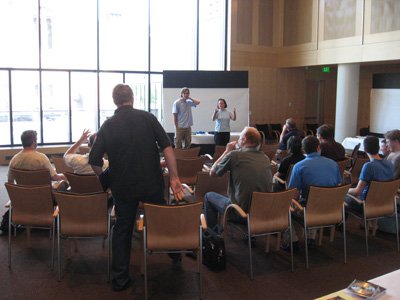
It’s a beautiful day in St. Paul, so we’re spending it indoors.
PublicRadio Camp is in session. MPR and MinneBar/MinneDemo pulled together the best-and-the-brightest from the online world, just to try an experiment on changing the way information is used.
High falutin’ stuff, to be sure. And, like any experiment, it may succeed, it may fail, but ultimately something will come of it that may impact how you process information. The results may pop up on some of the more innovative Web sites.
The larger group has broken down into groups of various interests and they’ve been given a CD full of data — audio of an unedited interview with a band on The Current, for example. Each group is kicking around ideas in such areas as user-generated content, political information, maps, using timelines, media sharing, laying content out in a different way, etc.
There are some Twitter feeds among the group members and I’ll try to find a link to them.
In the meantime, stop back from time to time and see what they’ve come up with.
Updates
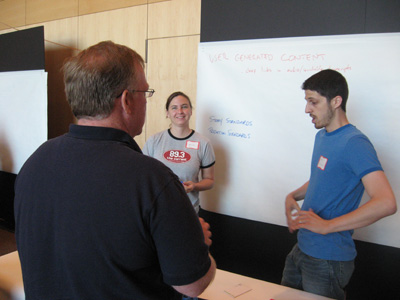
This group — Jon Gordon and Julia Schrenkler of MPR are shown — is noodling on user-generated content. Bruno Bornstein points out an important element of this. Media companies who want to do user-generated content, are going to have to “share the secret sauce,” and give the audience — you — access to servers and content that traditionally companies have guarded. But when you think of it, what could be more public than that?
I was just with this group diagramming how a radio story is produced. Now we’re talking about worldwide editing, and trying to figure out the challenge of meeting standards, without beating the creativity out of the author.
Note to self: Check with this group later.
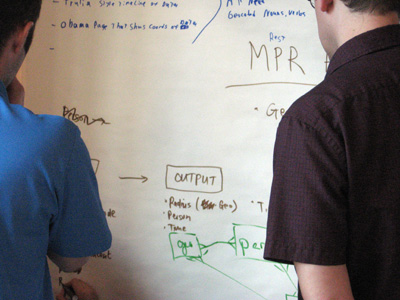
This is the flaw of having your News Cutter telling you about this stuff. I’m decidedly not tech savvy. But these folks (above) are considering the power of metadata. They’re talking about geocoding, for example. One of the notes on their board says “violent agreement.” We’ll check back.
update 10:45 Twitterers here (Tweeters?) include Andy Beger, the brains behind apps such as Select A Candidate (@thrym), @juliaschrenkler; Phil Wilson (@philson)
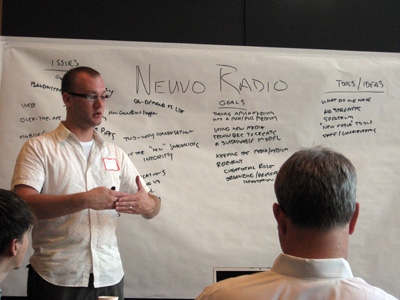
10:54 a.m. – This group has selected Neuvo Radio as its idea. I have nothing against radio, of course. I’ve been in it in one fashion or another for 35 or so years, but I long ago stopped thinking it was going to carve out a significant new role in the American media landscape. As one of this group’s goals is “keeping/making the medium relevant,” I’ll keep an open mind.
But I bet what they come up with makes some use of online. We’ll see. It’s worth noting this group has — at least for now — the most members.

11:09 a.m. – The folks who were working on data have apparently merged with the “visualization group.
By the way, how would I feel with I were an old-school newsroom editor/executive? Not too good. We — the societal “we” — are just now beginning to recognize that “news” and “content” is becoming much more collaborative. “The people” have the tools and, for the most part, the knowledge. Traditional news media has said “we’ll tell you what the news is when we’ve finished it.” But those days are ending and it’s alternately frightening and exciting to go through this change.
Take this blog, for example. And take last night’s weather posts. It’s run by a media company, of course, but it had no problem directing you to other media that had information (like that Willmar photo). That wouldn’t have happened 5, 10 years ago; media companies were interested only in the content that they developed themselves. Now expand this a bit, and add non-traditional media sources. Voila!
Can standards of integrity and traditional journalistic values survive this? Of course. How? I don’t know.
By the way, if you’re looking for the model of today’s event. You can read about it on the Minnov8 site.
11:27 a.m. — Did I mention what a gorgeous day it is in Minnesota?
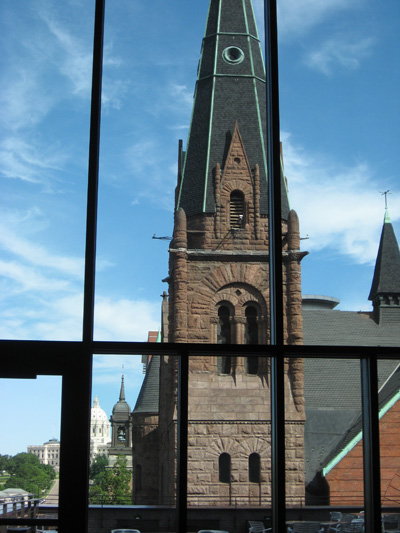
11:38 a.m. – One question I’ve been thinking about. How do you accomplish opening up this era of a more collaborative media environment, and not have it be more Twin Cities dominant. Outstate Minnesota — possibly by choice — is disconnected from this process as it exists now. Is it that outstate Minnesota isn’t interested? Is it that the infrastructure doesn’t exist. I think there are tons of stories outside of the Twin Cities and this process is perfect to get to them.
11:47 a.m. The “data” group has broken off from the “visualization” group again. I still don’t know exactly where they’re headed, but from the looks of things, it’s going to be interesting.
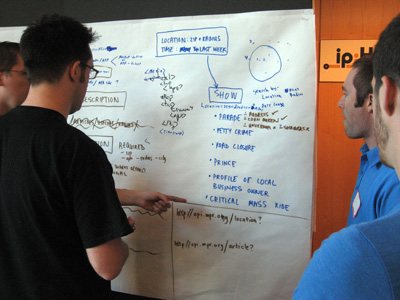
I was just remarking to Phil Wilson (remaincomm) that this is the group that makes me think that if I’d paid more attention in school, I could’ve made something of myself. The gentleman in the black is Ivan Stegic, known on Twitter as @ten7. It takes 5 — maybe 6 — seconds of talking to him before you realize he’s a genius.
12:26 p.m. We’re wrapping up with a “science fair.” The various groups are telling us what they came up with.
The “Fun with Data” group — Says MPR needs an API (application programming interface). All of MPR’s content and data could become available to all who desire it. The API would have a location, timerange and a keyword. People could use the API to develop applications surrounding MPR content.
“I think there’s a lot of cool applications,” Ivan said. “You could generate a cloud of words that describe content and the size of the words vary depending on their importance. You could draw a rectangle on a map and then see what all the words are for an area on a map that are important to that community. The API would reveal all of the relevant information. They could be articles or Twitter feeds. As you move a rectangle around on the map, the words would change.”
Jon Gordon wonders whether MPR produces enough “localish” content to create geographic specific content. But with collaborative content, users could contribute to this. I
Bob notes: This is really an example of media companies are going to have to think in a new way — that their content is part a whole, and not the whole.
User generated content – MPR is a “well-oiled journalism machine,” so the idea is to give people tools to create content in general and, possibly, for MPR. The group went over the current process by which content is created, and analyzed where the collaborative point is. One big idea was creative copyediting. Also putting the editorial process into the hands of people, whether or not they contribute it to MPR. A key part of this is a how-to guide somewhere on the MPR site regarding how to write, produce, interview, edit etc. “It’s franchising an idea,” Julia Schrenkler said.
“There are a lot of things to think about in considering a story,” Renee Schaefer said. What form does a story take? Is it better online? Different on the radio?
Part of this isn’t really difficult. What if, for example, we simply told you — the audience — what stories we were working on and then asked for help. In some ways we do that now, but the editorial process happens behind closed doors.
Jason DeRusha is, perhaps, the media member doing this on a small scale now with his Good Question, segment.
If people were to contribute content to MPR — or anyone else — how do they get paid? Do they get paid? Maybe it’s a different way of being a Public Radio member.
Where this process can make a difference, is the ability of the public to produce follow-up stories. Presently, we put out a story and then move on to another, but there’s usually a wealth of information that comes back to us as a result of a story that should find its way almost immediately into another story.
Visualization group – If you’re a regular blog reader, you’ve probably seen these applications (I think the NY Times does this) where a group of keywords get larger and smaller based on their importance. This group considered an idea where what people are talking about would make itself apparent online.
WCCO is doing something like this outside of its building in Minneapolis, with a series of projected words and such that change as the “tone” of the news changes.
This was demonstrated with something called “wordle.”
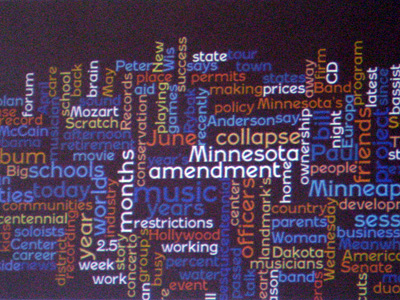
So one of the people here created a version of this with colors. He took various MPR RSS feeds and found the words that occurred most often and assigned importance via colors.

These would change from minute to minute and hour to hour. Someone remarked this is the new version of the old “weather ball.”
Here’s an example of this sort of visualization:
code_swarm – Eclipse (short ver.) from Michael Ogawa on Vimeo.
This is called “code_swarm” that represents a collaborative software project, showing people involved and changes made.
Neuvo Radio group – Keeping radio relevant. The group says it morphed into opening up radio and production and distribution mechanisms to users to create their own content and disseminate that content.
Jon Gordon had a “radio coffee shop” idea where people could go not only to have coffee, but also to use computers and other equipment to create radio, which would then be broadcast. This is an easier process now with the advent of high-definition radio.
Phil Wilson outlined ideas for radio to become a more integrated member of the community. “What was interesting was we started talking about that could happen, and Jon and I joked about taking the ‘dying medium of radio’ and the ‘dying industry of libraries’ and putting them together.”
Wilson says as they talked, they realize all of this comes down to more user involvement. Is the future of radio as a social media? “It has to be more controlled by the audience,” he said.
Another idea was an audioi stream of some fashion from a place like MPR that people could download as raw information, and use it to create their own stories.
An example: the MPR series on University Avenue. It would’ve been even more relevant to people on University Avenue, one presenter said, if part of it were written by a resident. So why not make elements available to initiate that follow-up story. That’s not to say the original wasn’t relevant — it was, to a wider audience.
Here’s an interesting idea outlined by Wilson: Getting radio away from being enslaved by the clock. “Does Future Tense really need to be on at the same time every day? What if it moved around from day to day?”
It was a fascinating four or five hours and, ideally, will result in more noodling on the changing media around us. Perhaps we can start in the comments section below.
Update 2:54 p.m. At Julia Schrenkler’s suggestion, I ran News Cut through wordle:
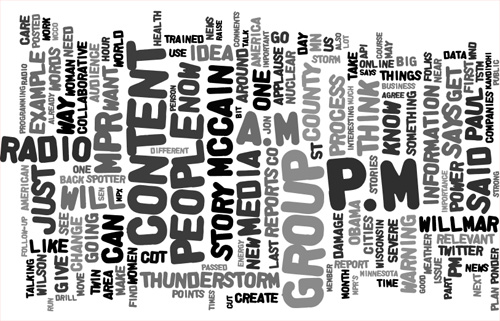
That would make a great coffee mug.
Not to throw water on things but on the way home today I remembered hearing a conversation in the newsroom this week. One person was asking another person what’s the point of having text-messaging on a cellphone.
